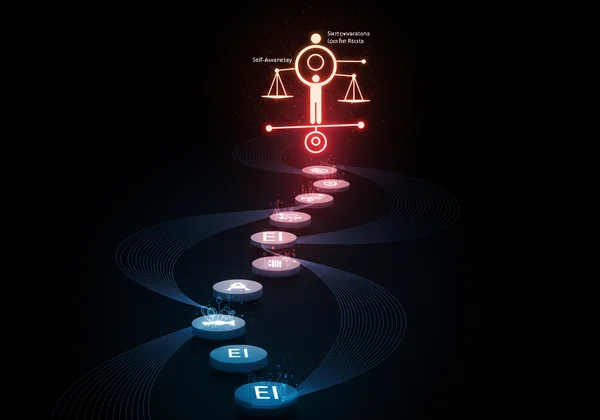Master Emotional Regulation & Control Emotions: Your EI Test Guide to Inner Calm
Feeling overwhelmed by stress, blindsided by anger, or stuck in a cycle of anxiety? You are not alone. These powerful emotional waves are a shared human experience. But what if you could learn to navigate them instead of being swept away? The key lies in a skill called emotional regulation. If you’ve ever wondered how to control emotions, this guide will provide you with a map to a calmer, more controlled inner world.
This article shares scientifically-backed techniques and practical strategies to help you manage your feelings effectively. By mastering these skills, you can learn to stay calm under pressure, improve your relationships, and cultivate lasting emotional well-being. The first step to understanding your unique emotional landscape is self-awareness, which you can begin to measure with a comprehensive EI test.

Understanding Emotional Regulation: Your Path to Inner Calm
Before diving into techniques, it's crucial to understand what emotional regulation truly means. It's not about ignoring or eliminating feelings; it's about learning to respond to them thoughtfully rather than reacting impulsively. This skill is a cornerstone of high emotional intelligence and is fundamental to personal and professional success.
What is Emotional Regulation (and Why Does it Matter)?
Emotional regulation is the ability to manage and influence which emotions you have, when you have them, and how you experience and express them. It's a complex process that involves monitoring, evaluating, and modifying your emotional reactions. Why is this so important? Individuals with strong emotional regulation skills tend to experience greater well-being, build stronger relationships, and perform better in academic and professional settings. They can handle stress more effectively, resolve conflicts constructively, and make more rational decisions, even when faced with intense feelings.
The Difference Between Suppressing and Healthily Regulating Emotions
A common mistake is confusing regulation with suppression. Suppression involves bottling up your feelings and pretending they don't exist. While it might offer temporary relief, this approach often leads to emotions resurfacing later, sometimes more intensely. Healthy regulation, on the other hand, is about acknowledgment. It means facing your emotions with curiosity, understanding their message, and then choosing a constructive way to manage them. This approach fosters genuine emotional health and resilience.
Scientifically-Backed Techniques to Stay Calm Under Pressure
When emotions run high, having a toolkit of immediate strategies can make all the difference. These techniques are designed to ground you in the present and shift your focus away from overwhelming feelings, allowing you to regain your composure.
Cognitive Reframing: Changing Your Thought Patterns
Our thoughts directly influence our emotions. Cognitive reframing is the psychological practice of changing the way you look at a situation, thereby changing your emotional response to it. For example, instead of viewing a challenging project at work as a threat ("I'm going to fail"), you could reframe it as an opportunity ("This is a chance to learn and showcase my skills"). By challenging negative or unhelpful thought patterns, you can actively reduce feelings of anxiety and stress.
Mindfulness & Deep Breathing: Anchor Yourself in the Present Moment
Mindfulness is the practice of paying attention to the present moment without judgment. When you feel a strong emotion rising, pause and focus on your breath. Inhale slowly through your nose for a count of four, hold for four, and exhale slowly through your mouth for a count of six. This simple act of deep breathing activates the body's relaxation response, slowing your heart rate and calming your nervous system. It creates a space between the emotional trigger and your reaction, giving you a moment to choose your response.

Body Scan & Progressive Muscle Relaxation: Releasing Physical Tension
Emotions often manifest as physical tension. Progressive muscle relaxation involves tensing and then relaxing different muscle groups throughout your body. Start with your toes, tensing them for five seconds, then releasing the tension for thirty seconds. Slowly work your way up your body—legs, abdomen, arms, and face. This practice helps you become more aware of where you hold stress and teaches you to consciously release that physical tension, which in turn calms your emotional state.
Emotional Labeling: Name It to Tame It
Research shows that simply putting your feelings into words can reduce their intensity. This technique, sometimes called "name it to tame it," involves acknowledging and labeling your emotion. Instead of just feeling a storm of negativity, try to identify it specifically: "I am feeling disappointed," or "I am feeling anxious about this meeting." This act of labeling engages the more rational part of your brain, dampening the response of the emotional centers and giving you a greater sense of control. To better understand your default emotional reactions, you can get your EI score.
Cultivating Long-Term Self-Regulation Skills for Lasting Change
While immediate techniques are useful, building lasting emotional mastery requires developing deeper, long-term habits. These skills are about creating a foundation of emotional resilience that supports you through all of life's ups and downs. True growth begins with a clear understanding of where you stand, which an EI test or EI assessment can provide.
Identifying Your Emotional Triggers and Patterns
Self-awareness is the first step toward change. Pay attention to what situations, people, or thoughts consistently provoke strong emotional reactions in you. These are your triggers. You can keep a simple journal to track your emotions throughout the day, noting what was happening when a strong feeling emerged. Over time, you'll begin to see patterns, giving you the power to anticipate and prepare for challenging situations, or even avoid unnecessary triggers altogether.
Building Resilience: Practicing Emotional Agility
Resilience isn't about being unaffected by adversity; it's about your ability to bounce back from it. A key component of this is emotional agility—the capacity to experience your thoughts and feelings without getting hooked by them. It involves accepting your emotions as natural, temporary signals, not as directives you must obey. Practicing emotional agility, a key component measured by any good EI test, helps you adapt to changing circumstances and navigate life's challenges with greater flexibility and strength.
The Role of Lifestyle: Sleep, Nutrition, and Exercise in Emotional Health
Your physical health and emotional health are deeply intertwined. A lack of sleep can significantly impair your ability to manage emotions, making you more irritable and reactive. A balanced diet provides your brain with the fuel it needs to function optimally. Regular exercise is a powerful mood regulator, releasing endorphins that relieve stress and promote feelings of well-being. Prioritizing these fundamental aspects of your lifestyle is one of the most effective ways to build a strong foundation for emotional stability.

Take Control: Your Journey to Emotional Mastery Begins Now
Learning how to control emotions is not a destination but a lifelong journey. It begins with the understanding that emotional regulation is a skill that can be learned and strengthened over time. By practicing cognitive reframing, mindfulness, and self-awareness, you can move from being controlled by your feelings to being in command of them.
Ready to understand your unique emotional patterns and identify specific areas for growth? Our AI-powered EI test can provide personalized insights into your self-regulation strengths and challenges. Take your free EI test today and unlock your path to emotional mastery!

Frequently Asked Questions About Emotional Regulation & EI
How do I know if I have good emotional regulation skills?
You likely have strong emotional regulation skills if you can remain calm during stressful situations, think clearly before acting on strong feelings, and bounce back relatively quickly from setbacks. People with high self-regulation also tend to communicate their feelings constructively and maintain stable relationships. A scientifically-validated EI test can offer objective insights into your specific strengths.
What are the signs of high emotional intelligence in daily life?
Signs of high emotional intelligence include empathy (understanding others' feelings), strong self-awareness (knowing your own emotions and how they affect you), and excellent social skills. People with high EI are often seen as approachable, good listeners, and effective leaders. They handle criticism well and are adept at managing conflict.
Can an EI test help me improve my ability to control emotions?
Absolutely. An emotional intelligence test serves as a powerful starting point. It provides a detailed snapshot of your current emotional intelligence, including your ability to regulate your own emotions. By highlighting your specific strengths and areas for development, the results from an EI test online give you a personalized roadmap for growth, helping you focus your efforts where they will have the most impact.